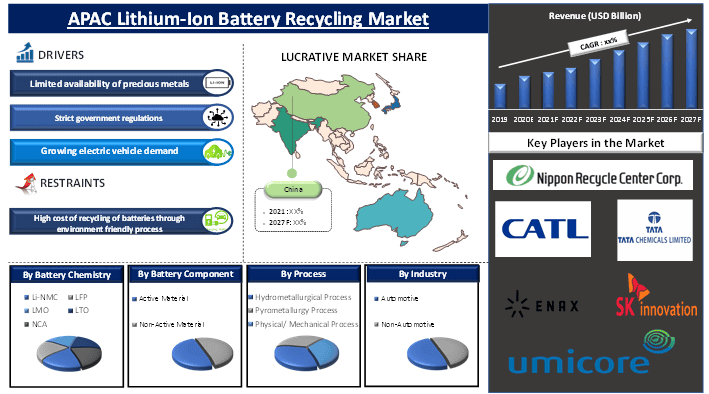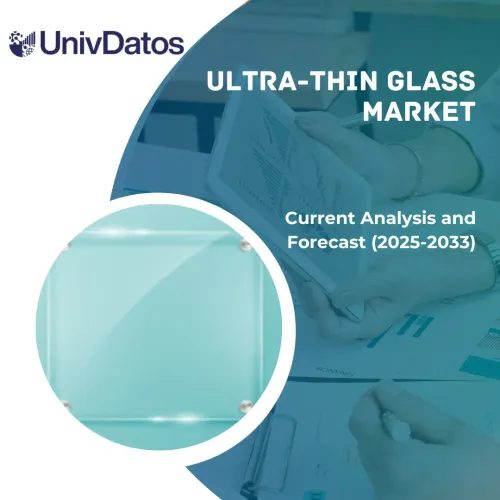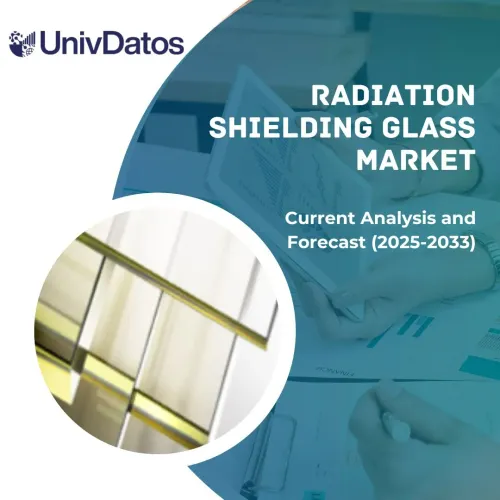- Home
- About Us
- Industry
- Services
- Reading
- Contact Us
Asia-Pacific Lithium-Ion Battery Recycling Market: Current Analysis and Forecast (2021-2027)
Emphasis on Battery Chemistry (Li-NMC, LFP, LMO, LTO, and NCA); Battey Component (Active Component and Non-Active Component); Process (Hydrometallurgical Process, Pyrometallurgy Process, and Physical/Mechanical Process); Industry [Automotive and Non-Automotive (Industrial, Power, Marine, and Others)]; and Country
RD_APAC Lithium-Ion Battery Recycling Market Current Scenario and Forecast (2021-2027)
The regional Lithium-Ion Battery Recycling market is likely to showcase double digit growth during the forecast period (2021-2027). Globally, lithium-ion batteries are witnessing growing demand from across the sectors. Shifting trend towards e-mobility, increasing demand of consumer electronics products in developing economies owing to improving people lifestyle, and growing concern in industries to reduce the carbon emission are some of the key attributable factors for the growth of the battery manufacturing industry. Owing to which, demand of raw materials like nickel and lithium is increasing. For instance, global production of lithium from mine was 28.4 thousand ton in 2020 which has increased to 90.2 thousand ton in 2019 and 86.3 thousand ton in 2020. These materials are all non-renewables, can be recycled an indefinite number of times, and have a commercial value. Therefore, recycling of lithium-ion batteries offering a huge market opportunity in order to meet the growing demand. Since, APAC region has the lowest cost of industrial operations, therefore regional and global players are making investment in the regional lithium-ion battery recycling market.
In light of COVID-19, industrial capex had decreased in order to sustain during the pandemic. Several industrial settings were bankrupting or closed their operation owing to the liquidity crunch or labor unavailability. Moreover, border closure disrupted the raw materials supply-demand. Since, recycling of batteries requires a fully efficient supply chain which had been broken down in the light of COVID-19, thus affecting the market performance.
Insights Presented in the Report
“Amongst battery chemistry, Li-NMC held significant share in the market in 2020.”
Based on battery chemistry, the market is categorized into Li-NMC, LFP, LMO, LTO, and NCA. Among these, Li-NMC held the prominent share in the market and is expected to showcase robust growth during the forecast period. This can be mainly attributed to its large adoption by e-mobility industry. Further, increasing adoption of electric vehicles is fueling the demand of Li-NMC battery, thus availability of large volume of Li-NMC end of life batteries for recycling purpose.
“Amongst battery component, active material held the prominent share in the market in 2020.”
Based on battery component, the market is bifurcated into active component and non-active component. Among these, active component held the significant market share in terms of value in 2020 owing to high value associated with the active component.
“China held the largest share in the APAC Lithium-Ion Battery Recycling Market”
For a better understanding of the market adoption of lithium-ion battery recycling, the market is analyzed based on its regional presence in the countries such as Japan, South Korea, Australia, India, Taiwan, and Rest of APAC. China had the prominent share in the regional lithium-ion battery recycling market pie. This is mainly ascribed to the increasing awareness among battery manufacturer and government to properly utilize the limited resources and government supporting schemes to promote the recycling activities in the country. Further, country is the largest consumer of electric vehicles therefore to mitigate the supply-demand gap, battery manufacturers are increasingly focusing on battery recycling.
Reasons to buy this report:
- The study includes market sizing and forecasting analysis validated by authenticated key industry experts
- The report presents a quick review of overall industry performance at one glance
- The report covers in-depth analysis of prominent industry peers with a primary focus on key business financials, product portfolio, expansion strategies, and recent developments
- Detailed examination of drivers, restraints, key trends, and opportunities prevailing in the industry
- The study comprehensively covers the market across different segments
- Deep dive country level analysis of the industry
Customization Options:
The APAC Lithium-Ion Battery Recycling market can further be customized as per the requirement or any other market segment. Besides this, UMI understands that you may have your own business needs, hence feel free to connect with us to get a report that completely suits your requirements.
Table of Content
Analyzing the historical market, estimation of the current market, and forecasting the future market of the Lithium-Ion Battery Recycling three major steps undertaken to create and analyze its adoption across the region. Exhaustive secondary research was conducted to collect the historical market numbers and estimate the current market size. Secondly, to validate these insights, numerous findings and assumptions were taken into consideration. Moreover, exhaustive primary interviews were also conducted, with industry experts across the value chain of the Lithium-Ion Battery Recycling industry. Post assumption and validation of market numbers through primary interviews, we employed a bottom-up approach to forecast the complete market size. Thereafter, market breakdown and data triangulation methods were adopted to estimate and analyze the market size of segments and sub-segments the industry pertains to. Detailed methodology is explained below:
Analysis of Historical Market Size
Step 1: In-Depth Study of Secondary Sources:
Detail secondary study was conducted to obtain the historical market size of the Lithium-Ion Battery Recycling through company internal sources such as annual report & financial statements, performance presentations, press releases, etc., and external sources including journals, news & articles, government publications, competitor publications, sector reports, third-party database, and other credible publications.
Step 2: Market Segmentation:
After obtaining the historical market size of the Lithium-Ion Battery Recycling market, we conducted a detailed secondary analysis to gather current market insights and share for different segments & sub-segments for major countries. Major segments included in the report are by battery chemistry, battery component, process, and industry.
Step 3: Factor Analysis:
After acquiring the historical market size of different segments and sub-segments, we conducted a detailed factor analysis to estimate the current market size of Lithium-Ion Battery Recycling. Further, we conducted factor analysis using dependent and independent variables such as increasing focus on circular economy and growing concern on depleting precious and rare earth metal. A thorough analysis was conducted for demand and supply-side scenario considering increasing investment, top partnerships, merger and acquisition, business expansion, and product launches in the Lithium-Ion Battery Recycling industry.
Current Market Size Estimate & Forecast
Current Market Sizing: Based on actionable insights from the above 3 steps, we arrived at the current market size, key players in the regional Lithium-Ion Battery Recycling market, and market shares of each segment. All the required percentage shares split, and market breakdowns were determined using the above-mentioned secondary approach and were verified through primary interviews.
Estimation & Forecasting: For market estimation and forecast, weights were assigned to different factors including drivers & trends, restraints, and opportunities available for the stakeholders. After analyzing these factors, relevant forecasting techniques i.e., bottom-up approach was applied to arrive at the market forecast to 2027 for different segments and subsegments across the major regional countries. The research methodology adopted to estimate the market size encompasses:
- The industry’s market size, in terms of value (US$) and the adoption rate of Lithium-Ion Battery Recycling across the major markets
- All percentage shares, splits, and breakdowns of market segments and sub-segments
- Key players in the Lithium-Ion Battery Recycling market in terms of recycling capacity. Also, the growth strategies adopted by these players to compete in the fast-growing market.
Market Size and Share Validation
Primary Research: In-depth interviews were conducted with the Key Opinion Leaders (KOLs) including Top Level Executives (CXO/VPs, Sales Head, Marketing Head, Operational Head, and Regional Head, Country Head, etc.) across major countries. Primary research findings were then summarized, and statistical analysis was performed to prove the stated hypothesis. Inputs from primary research were consolidated with secondary findings, hence turning information into actionable insights.
Split of Primary Participants in Different Countries
Market Engineering
Data triangulation technique was employed to complete the overall market estimation and to arrive at precise statistical numbers of each segment and sub-segment of the Lithium-Ion Battery Recycling market. Data was split into several segments & sub-segments post studying various parameters and trends in the areas of battery chemistry, battery component, process, and industry.
The main objective of the Lithium-Ion Battery Recycling market study
The current & future market trends of regional Lithium-Ion Battery Recycling were pinpointed in the study. Investors can gain strategic insights to base their discretion for investments from the qualitative and quantitative analysis performed in the study. Current and future market trends would determine the overall attractiveness of the market at a country level, providing a platform for the industrial participant to exploit the untapped market to benefit as a first-mover advantage. Other quantitative goals of the studies include:
- Analyze the current and forecast market size of Lithium-Ion Battery Recycling in terms of value (US$). Also, analyze the current and forecast market size of different segments and sub-segments
- Segments in the study include areas of battery chemistry, battery component, process, and industry
- Defined analysis of the regulatory framework for the Lithium-Ion Battery Recycling industry
- Analyze the value chain involved with the presence of various intermediaries, along with analyzing customer and competitor behaviors of the industry
- Analyze the current and forecast market size of the Lithium-Ion Battery Recycling for the major countries
- Major countries analyzed in the report includes China, Japan, India, Australia, Taiwan, and Rest of APAC
- Company profiles of the Lithium-Ion Battery Recycling market players and the growth strategies adopted by them to sustain in the growing market
Deep dive country level analysis of the industry
Related Reports
Customers who bought this item also bought










